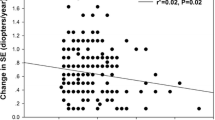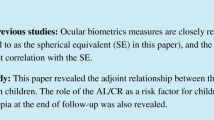Abstract
Purpose
To investigate the effects of no correction versus full correction on myopia progression in Chinese children over a period of 2 years.
Methods
Myopia was defined as cycloplegic spherical equivalent (SE) of ≤ −0.50 D. Uncorrection was defined as no spectacles worn, and full correction was defined as when the value of SE subtracted from the dioptric power of the child’s current spectacles was less than 0.5 D. Ocular examinations included visual acuity, cycloplegic autorefraction, axial length and vertometer measurements. Questionnaires were completed by parents on behalf of the children.
Results
A total of 121 myopic children, with a median age of 12.7 years, were screened from the Anyang Childhood Eye Study, with 65 in the uncorrected group and 56 in the full correction group. At 2-year follow-up, children with no correction had slower myopia progression (−0.75 ± 0.49 D vs. −1.04 ± 0.49 D, P < 0.01) and less axial elongation (0.45 ± 0.18 mm vs. 0.53 ± 0.17 mm, P = 0.02) than children with full correction. In multivariate modeling, adjusting for baseline SE or axial length, age, gender, height, number of myopic parents, age at myopia onset, and time spent in near work and outdoors, children with no correction still had slower myopia progression (−0.76 ± 0.07 vs. −1.03 ± 0.08 D, P < 0.01) and less axial elongation (0.47 ± 0.03 mm vs. 0.51 ± 0.03 mm, P < 0.01). Myopia progression decreased significantly with an increasing amount of undercorrection in all children (r = 0.22, b = 0.16, P = 0.01).
Conclusion
Our findings suggest that myopic defocus slows the progression of myopia in already myopic children, supporting previous findings from animal studies.




Similar content being viewed by others
References
Pan CW, Ramamurthy D, Saw SM (2012) Worldwide prevalence and risk factors for myopia. Ophthalmic Physiol Optics : J Brit College Ophthalmic Optic 32:3–16. doi:10.1111/j.1475-1313.2011.00884.x
Saw SM, Gazzard G, Shih-Yen EC, Chua WH (2005) Myopia and associated pathological complications. Ophthalmic Physiol Opt 25:381–391
Holden BA, Fricke TR, Wilson DA, Jong M, Naidoo KS, Sankaridurg P, Wong TY, Naduvilath TJ, Resnikoff S (2016) Global prevalence of myopia and high myopia and temporal trends from 2000 through 2050. Ophthalmology 123:1036–1042. doi:10.1016/j.ophtha.2016.01.006
Resnikoff S, Pascolini D, Mariotti SP, Pokharel GP (2008) Global magnitude of visual impairment caused by uncorrected refractive errors in 2004. Bull World Health Organ 86:63–70
Lim MC, Gazzard G, Sim EL, Tong L, Saw SM (2009) Direct costs of myopia in Singapore. Eye (Lond) 23:1086–1089
Walline JJ, Lindsley K, Vedula SS, Cotter SA, Mutti DO, Twelker JD (2011) Interventions to slow progression of myopia in children. the Cochrane database of systematic reviews: CD004916. doi: 10.1002/14651858.CD004916.pub3
Li SM, Ji YZ, Wu SS, Zhan SY, Wang B, Liu LR, Li SY, Wang NL, Wang JJ (2011) Multifocal versus single vision lenses intervention to slow progression of myopia in school-age children: a meta-analysis. Surv Ophthalmol 56:451–460
Li SM, Wu SS, Kang MT, Liu Y, Jia SM, Li SY, Zhan SY, Liu LR, Li H, Chen W, Yang Z, Sun YY, Wang N, Millodot M (2014) Atropine slows myopia progression more in Asian than white children by meta-analysis. Optom Vis Sci 91:342–350
Li SM, Kang MT, Wu SS, Liu LR, Li H, Chen Z, Wang N (2015) Efficacy, safety and acceptability of orthokeratology on slowing axial elongation in myopic children by meta-analysis. Curr Eye Res: 1–9
Flitcroft DI (2013) Is myopia a failure of homeostasis? Exp Eye Res 114:16–24. doi:10.1016/j.exer.2013.02.008
Arumugam B, Hung LF, To CH, Holden B, Smith EL, 3rd (2014) The effects of simultaneous dual focus lenses on refractive development in infant monkeys. Invest Ophthalmol Vis Sci 55: 7423-7432. doi: 7410.1167/iovs.7414-14250
Zhu X, McBrien NA, Smith EL 3rd, Troilo D, Wallman J (2013) Eyes in various species can shorten to compensate for myopic defocus. Invest Ophthalmol Vis Sci 54:2634–2644
Tse DY, To CH (2011) Graded competing regional myopic and hyperopic defocus produce summated emmetropization set points in chick. Invest Ophthalmol Vis Sci 52:8056–8062. doi:10.1167/iovs.10-5207
Adler D, Millodot M (2006) The possible effect of undercorrection on myopic progression in children. Clin Exp Optom 89:315–321
Angi MR, Forattini F, Segalla C, Mantovani E (1996) Myopia evolution in pre-school children after full optical correction. Strabismus 4:145–157
Chung K, Mohidin N, O’Leary DJ (2002) Undercorrection of myopia enhances rather than inhibits myopia progression. Vision Res 42:2555–2559
Phillips JR (2005) Monovision slows juvenile myopia progression unilaterally. Br J Ophthalmol 89:1196–1200
Tokoro T, Kabe S (1965) Treatment of the myopia and the changes in optical components. report II. full-or under-correction of myopia by glasses. Nihon Ganka Gakkai Zasshi 69:140–144
Benavente-Perez A, Nour A, Troilo D (2012) The effect of simultaneous negative and positive defocus on eye growth and development of refractive state in marmosets. Invest Ophthalmol Vis Sci 53:6479–6487
Xiang F, He M, Morgan IG (2012) Annual changes in refractive errors and ocular components before and after the onset of myopia in Chinese children. Ophthalmology 119:1478–1484. doi:10.1016/j.ophtha.2012.01.017
Mutti DO, Hayes JR, Mitchell GL, Jones LA, Moeschberger ML, Cotter SA, Kleinstein RN, Manny RE, Twelker JD, Zadnik K (2007) Refractive error, axial length, and relative peripheral refractive error before and after the onset of myopia. Invest Ophthalmol Vis Sci 48:2510–2519
Li SY, Li SM, Zhou YH, Liu LR, Li H, Kang MT, Zhan SY, Wang N, Millodot M (2015) Effect of undercorrection on myopia progression in 12-year-old children. Graefes Arch Clin Exp Ophthalmol 253:1363–1368. doi:10.1007/s00417-015-3053-8
Li SM, Liu LR, Li SY, Ji YZ, Fu J, Wang Y, Li H, Zhu BD, Yang Z, Li L, Chen W, Kang MT, Zhang FJ, Zhan SY, Wang NL, Mitchell P (2013) Design, methodology and baseline data of a school-based cohort study in Central China: the Anyang Childhood Eye Study. Ophthalmic Epidemiol 20:348–359
Li SM, Li SY, Liu LR, Zhou YH, Yang Z, Kang MT, Li H, Yang XY, Wang YP, Zhan SY, Mitchell P, Wang N, Atchison DA, the Anyang Childhood Eye Study G (2015) Peripheral refraction in 7- and 14-year-old children in central China: the Anyang Childhood Eye Study. Br J Ophthalmol 99:674–679. doi:10.1136/bjophthalmol-2014-305322
Zhu BD, Li SM, Li H, Liu LR, Wang Y, Yang Z, Li SY, Kang MT, Fu J, Qi YH, Zhan SY, Wang N, Anyang Childhood Eye Study G (2013) Retinal nerve fiber layer thickness in a population of 12-year-old children in central China measured by iVue-100 spectral-domain optical coherence tomography: the Anyang Childhood Eye Study. Invest Ophthalmol Vis Sci 54:8104–8111. doi:10.1167/iovs.13-11958
Vasudevan B, Esposito C, Peterson C, Coronado C, Ciuffreda KJ (2013) Under-correction of human myopia – is it myopigenic?: a retrospective analysis of clinical refraction data. J Optometr 7:147–152. doi:10.1016/j.optom.2013.12.007
Zhu X, Winawer JA, Wallman J (2003) Potency of myopic defocus in spectacle lens compensation. Invest Ophthalmol Vis Sci 44:2818–2827
Hung LF, Crawford ML, Smith EL (1995) Spectacle lenses alter eye growth and the refractive status of young monkeys. Nat Med 1:761–765
Smith EL 3rd (2013) Optical treatment strategies to slow myopia progression: effects of the visual extent of the optical treatment zone. Exp Eye Res 114:77–88. doi:10.1016/j.exer.2012.11.019
Morgan I, Rose K (2005) How genetic is school myopia? Prog Retin Eye Res 24:1–38. doi:10.1016/j.preteyeres.2004.06.004
Li SM, Li SY, Kang MT, Zhou Y, Liu LR, Li H, Wang YP, Zhan SY, Gopinath B, Mitchell P, Wang N, Anyang Childhood Eye Study G (2015) Near work related parameters and myopia in Chinese children: the Anyang Childhood Eye Study. PLoS One 10:e0134514. doi:10.1371/journal.pone.0134514
Guggenheim JA, Northstone K, McMahon G, Ness AR, Deere K, Mattocks C, Pourcain BS, Williams C (2012) Time outdoors and physical activity as predictors of incident myopia in childhood: a prospective cohort study. Invest Ophthalmol Vis Sci 53:2856–2865. doi:10.1167/iovs.11-9091
Li SM, Li H, Li SY, Liu LR, Kang MT, Wang YP, Zhang F, Zhan SY, Gopinath B, Mitchell P, Wang N, Anyang Childhood Eye Study G (2015) Time outdoors and myopia progression over 2 years in Chinese children: the Anyang Childhood Eye Study. Invest Ophthalmol Vis Sci 56:4734–4740. doi:10.1167/iovs.14-15474
Medina A (2015) The progression of corrected myopia. Graefes Arch Clin Exp Ophthalmol 253:1273–1277. doi:10.1007/s00417-015-2991-5
Webb H, Lee J (2004) Acquired distance esotropia associated with myopia. Strabismus 12:149–155. doi:10.1080/09273970490489694
Ghasia FF, Shaikh AG (2015) Uncorrected myopic refractive error increases microsaccade amplitude. Invest Ophthalmol Vis Sci 12:14–15882
Li SM, Li SY, Liu LR, Guo JY, Chen W, Wang NL, Millodot M (2013) Full correction and undercorrection of myopia evaluation trial: design and baseline data of a randomized, controlled, double-blind trial. Clin Experiment Ophthalmol 41:329–338. doi:10.1111/j.1442-9071.2012.02884.x
Acknowledgments
This study was supported by the Beijing Nova Program (Z121107002512055), the National Natural Science Foundation of China (81300797), the Major International (Regional) Joint Research Project of the National Natural Science Foundation of China (81120108007), the Major State Basic Research Development Program of China (“973” Program, 2011CB504601) of the Ministry of Science and Technology, and the Research Foundation of Beijing Tongren Hospital Affiliated to Capital Medical University (2012-YJJ-019). We thank He Li, Yi-Peng Wang, Si-Yan Zhan, and Xiu-Hua Wan for their help on this study.
Author information
Authors and Affiliations
Corresponding authors
Ethics declarations
Conflict of interest
All authors certify that they have no affiliations with or involvement in any organization or entity with any financial interest (such as honoraria; educational grants; participation in speakers’ bureaus; membership, employment, consultancies, stock ownership, or other equity interest; or expert testimony or patent-licensing arrangements) or non-financial interest (such as personal or professional relationships, affiliations, knowledge or beliefs) in the subject matter or materials discussed in this manuscript.
Ethical approval
This study was approved by the institutional review board of Beijing Tongren Hospital, Capital Medical University. The ACES conformed to the tenets of the Declaration of Helsinki.
Informed consent
Written informed consent from at least one parent and verbal assent from children were obtained after explanation of the nature and possible consequences of the study.
Rights and permissions
About this article
Cite this article
Sun, YY., Li, SM., Li, SY. et al. Effect of uncorrection versus full correction on myopia progression in 12-year-old children. Graefes Arch Clin Exp Ophthalmol 255, 189–195 (2017). https://doi.org/10.1007/s00417-016-3529-1
Received:
Revised:
Accepted:
Published:
Issue Date:
DOI: https://doi.org/10.1007/s00417-016-3529-1




